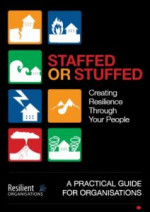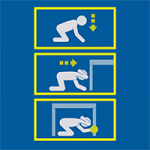ShakeOut information for businesses and organisationsNgā mōhiohio ShakeOut mā ngā pakihi me ngā tāngata
New Zealand ShakeOut is our national earthquake drill and tsunami hīkoi (evacuation walk).
Taking part is a great way for everyone in your organisation to learn the right actions to take before, during and after an earthquake and tsunami.
On this page
Why prepare your business?
An emergency plan is a health and safety requirement. Not having one is a big risk for your business and the people in it.
Being prepared for an emergency or disaster can:
- save lives and prevent harm,
- help businesses to continue trading through hardship,
- give staff and owners confidence,
- protect equipment and premises, and
- quickly get businesses running again.
Get ready for ShakeOut
Leading up to ShakeOut, there are lot's of things your organisation can do to get ready for an emergency.
- Identify safe places to Drop, Cover and Hold and practise the drill with your staff.
- Check if your business or organisation is in a tsunami evacuation zone. Make plans for a tsunami hīkoi if you are in a coastal area.
- Your staff should know what to do in an emergency at work. Get staff together to discuss the drill and what might happen in a real emergency.
- Encourage staff to fill in a Personal Workplace Emergency Plan.
- If your staff have grab bags at work, get them to check that everything is up-to-date. If your staff don't have grab bags, provide them with some or encourage them to make their own.
- Check that your organisation has a business continuity plan and an emergency plan. A business continuity plan is different from an emergency plan. Emergency plans cover events like natural disasters. Business continuity plans cover how you’ll get core parts of your business up and running again.
Sign up for ShakeOut
ShakeOut takes place across the world to remind people of the right action to take during an earthquake. Drop, Cover and Hold. You can also practise a tsunami hīkoi (evacuation) if you're in a coastal area.
Sign up for ShakeOut!
Sign up for shakeout
Test your plans
On ShakeOut day, try testing some of your other plans as well.
- After your drill, discuss with staff some what-if scenarios and what might happen next in a real emergency.
- Practise restoring your data.
- Try working without cellphones for an hour. How does it affect your work?
Doing the drill
ShakeOut is a self-run drill. You can start it in whatever way works for you. You could:
- use a bell, whistle or alarm
- play the New Zealand ShakeOut Announcement over your PA system
- shout “EARTHQUAKE DRILL”, or
- tune in to our Facebook livestream.
Drop, Cover and Hold for 30–60 seconds:
- DROP down on your hands and knees. This protects you from falling but lets you move if you need to.
- COVER your head and neck (or your entire body if possible) under a sturdy table or desk (if it is within a few steps of you). If there is no shelter nearby, cover your head and neck with your arms and hands.
- HOLD on to your shelter (or your position to protect your head and neck) until the shaking stops. If the shaking shifts your shelter around, move with it.
While you are doing the drill, take note of what might be happening around you in a real earthquake. Think about what you might need to do to prepare for a real earthquake.
Then if you are in a tsunami evacuation zone, practice your tsunami hīkoi. Move immediately to the nearest high ground or as far inland as you can out of tsunami evacuation zones.
Practicing your tsunami hīkoi means you know where to go if there is a Long or Strong earthquake. Remember if an earthquake is Long or Strong, Get Gone.

Use this New Zealand ShakeOut audio announcement to start your earthquake drill. Play it through a speaker or PA so everyone knows the correct action to take.
After the drill
After your drill is complete:
- Talk with staff and colleagues about what you learned.
- Make changes to your business/organisation's emergency plan or business continuity plan.
- Find out what other actions you can take to make your business more prepared.
- Encourage staff to make a Household Emergency Plan at home.
- Share your ShakeOut photos, videos and stories on social media.
Share the ShakeOut
It’s important that your staff, customers and clients know what to do on drill day as well. You never know who’s going to be around in an emergency.
- Share the ShakeOut on social media to let people know what you're going to be doing on drill day.
- Share a link to shakeout.govt.nz(external link) on your website. Email shakeout@nema.govt.nz to request digital banners in the size you need.
Resources

Use this guide on what to include in your emergency planning from business.govt.nz.

Find advice for looking after staff in an emergency.

Have staff fill in a personal workplace emergency plan to plan for an emergency during work hours.

Continuity and contingency planning is about being prepared for all types of disruptions. Use the business.govt.nz step-by-step guide to get your plan sorted. It’s vital to your business’s survival.

Download and share this factsheet on what to do before, during and after an earthquake.

Tīkina ake, tiria hoki tēnei pukameka mō ngā mahi me whakamahi ā mua, ā roto, ā muri hoki i tētahi rū whenua.
Download and share this factsheet on what to do before, during and after an earthquake.

Download and share this factsheet in English about what to do before, during and after a tsunami.

Tīkina ake, tiria hoki tēnei pukameka mō ngā mahi me whakamahi ā mua, ā roto, ā muri hoki i tētahi ngaru taitoko.
Download and share this factsheet in Te Reo Māori about what to do before, during and after a tsunami.
How to ShakeOut
Find information on ShakeOut for schools, businesses and individuals.


